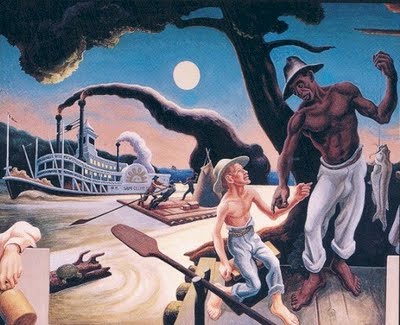After studying in Europe, Benton moved to New York City in 1913 and resumed painting. During World War I he served in the U.S. Navy and was stationed at Norfolk, Virginia. His war-related work had an enduring effect on his style. He was directed to make drawings and illustrations of shipyard work and life, and this requirement for realistic documentation strongly affected his later style. (Note: Part 4 of these posts will feature Benton’s war art)
On his return to New York in the early 1920s, Benton declared himself an "enemy of modernism"; he began the naturalistic and representational work today known as Regionalism. Benton was active in leftist politics. He expanded the scale of his Regionalist works, culminating in his America Today murals at the New School for Social Research in 1930-31. These now hang in the lobby of the AXA building at 1290 Sixth Avenue in New York City. He was strongly influenced by the works of the Spanish artist El Greco.
 |
| 1930 City Activities with Dance Hall |
 |
| 1930 City Activities with Subway |
In 1934 Benton was featured on one of the earliest colour covers of Time magazine. Benton's work was featured along with that of fellow Mid-westerners Grant Wood and John Steuart Curry in an article entitled "The U.S. Scene". The trio were featured as the new heroes of American art, and Regionalism was described as a significant art movement.
He settled in Kansas City, Missouri and accepted a teaching job at the Kansas City Art Institute. Kansas City afforded Benton greater access to rural America, which was changing rapidly. Benton's sympathy was with the working class and the small farmer. In the late 1930s, he created some of his best-known work, including the iconic allegorical nude Persephone, which for a while hung in Billy Rose’s nightclub, the Diamond Horseshoe. It is now held by the Nelson-Atkins Museum of Art in Kansas City.
 |
| 1938-9 Persephone oil on canvas 183 x 142 cm |
During this period, Benton also began to produce signed, limited edition lithographs which were sold at $5.00 each through the Associated American Artists galleries. (Note: Part 3 of these posts will feature Benton’s lithographs)
During World War II, Benton created a series titled The Year of Peril, which portrayed the threat to American ideals by fascism and Nazism. The prints were widely distributed.
 |
| The Year of Peril - Embarkation |
 |
| The Year of Peril - Sowers |
Note: Sizes given have been rounded up or down to the nearest whole centimetre:
 |
| n.d. Cotton Bin oil on tin 23 x 33 cm |
 |
| 1920 People of Chilmark (Figure Compostion) oil on canvas 166 x 197cm |
 |
| 1921 The Cliffs oil on canvas 74 x 88 cm |
 |
| 1922 Chilmark Landscape oil on paper 39 x 58 cm |
 |
| 1922 Self-Portrait with Wife Rita |
 |
| 1926 The Lord is my Shepherd tempera on canvas 84 x 69 cm |
 |
| 1928 Boomtown oil on canvas 117 x 138 cm |
 |
| 1928 The Cotton Pickers |
 |
| 1931-2 Romance tempera and oil on panel 114 x 84 cm |
 |
| 1932 Arts of the West |
 |
| 1932 The Arts of the City |
 |
| 1934 Lord, Heal the Child |
 |
| 1934 The Ballad of the Jealous Lover of Lone Green Valley tempera and oil on canvas 105 x 133 cm |
 |
| 1936 A Social History of the State of Missouri, Huckleberry Finn |
 |
| 1936 Kansas City from Politics, Farming and the Law |
 |
| 1938 Roasting Ears |
 |
| 1938 The Flood |
 | |
| 1938 Threshing Wheat |
 |
| 1938 TP and Jake |
No comments:
Post a Comment
Note: only a member of this blog may post a comment.